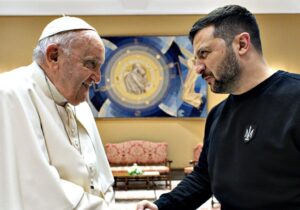As Americans wade through the shock, grief, and consequent anxiety of the Orlando massacre—which takes its place alongside San Bernardino, Chattanooga, Moore, Boston, Ft. Hood, and Little Rock in the growing tally of jihadist attacks on American soil since 9/11—I am reminded of something Adm. Eric Olson said in 2011. Olson, then-commander of U.S. Special Operations Command, concluded that “al-Qaeda version 1.0 is nearing its end.” He then added an ominous caveat: “I’m very concerned about what al-Qaeda version 2.0 will be.”
His worries were well-founded. After Orlando and San Bernardino, Brussels and Paris, Mosul and Sinjar, we know that al-Qaeda 2.0—better known as “ISIS”—is not a “JV team” in “Lakers uniforms,” but rather a more virulent, more vicious, more violent version of al-Qaeda 1.0.
In the shadow cast by 9/11, it’s difficult to believe something could be worse than al-Qaeda 1.0. But with American nightclubs and office buildings awash in blood, with Europe under siege, with Christians and Yazidis targeted for extermination, with the Pandora’s Box of chemical warfare reopened, with the female populations of entire cities enslaved, here we are.
Consider that al-Qaeda 1.0 was kicked out of Sudan, consigned to a tiny corner of Afghanistan, had a modest financial base, and fielded a small core of deeply committed, mostly-Arab footsoldiers. By 2011, al-Qaeda 1.0 had been whittled down to 3,000 operatives.
Today, ISIS fields an army of 36,000 fighters (6,600 from Western countries). ISIS has a $56-million monthly revenue stream. Even after two years of U.S. airstrikes, ISIS controls some 20,000 square-miles of Iraq and Syria. Thirty-four militant groups from around the world have pledged allegiance to ISIS. ISIS has committed genocide against Yazidis and Christians. ISIS and its henchmen have murdered at least 1,440 people in 90 terrorist attacks in 21 countries outside Iraq and Syria, including massacres in San Bernardino and Orlando. The FBI has 900 active investigations into ISIS-inspired operatives in all 50 states.
ISIS did not emerge out of thin air. As The Financial Times has reported, the remnants of al-Qaeda in Iraq (AQI) “morphed into the earliest version of ISIS.”
It pays to recall that the surge of U.S. forces into Iraq in 2007-09 eviscerated AQI. By every metric, post-surge Iraq was in better shape than pre-surge Iraq. The Pentagon consensus was that Iraq needed the U.S. military’s support to sustain the upward trajectory of the surge: Gen. Lloyd Austin (commander of U.S. Forces-Iraq) recommended keeping 20,000 troops in Iraq. Joint Chiefs Chairman Adm. Mike Mullen urged the White House to keep at least 16,000 troops in Iraq as an insurance policy. Defense Secretary Robert Gates and Gen. James Mattis (CENTCOM commander) concurred. “None of us recommended that we completely withdraw from Iraq,” Gen. Martin Dempsey, Adm. Mullen’s successor, later noted.
But President Obama always viewed U.S. involvement in Iraq as a problem to be corrected, rather than a commitment to be sustained. As former Defense Secretary Leon Panetta laments, the White House was “so eager to rid itself of Iraq that it was willing to withdraw rather than lock in arrangements that would preserve our influence and interests.”
There was nothing surprising about President Obama’s eagerness to bring America’s war in Iraq to a close. Regrettably, nor was there anything surprising about the results:
- In October 2011, Col. Salam Khaled of the Iraqi army warned, “Our forces are good but not to a sufficient degree that allows them to face external and internal challenges alone.”
- In January 2012, Gen. Jeffrey Buchanan worried, “Without all the enablers we provide, there’s no doubt there will be less capability than there is right now,”adding that if Iraqi troops prove unable to put pressure on jihadist groups, “they could regenerate.”
- In February 2014, State Department official Brett McGurk told Congress that ISIS aimed “to cause the collapse of the Iraqi state and carve out a zone of governing control in western regions of Iraq and Syria.”
It’s no coincidence that al-Qaeda 2.0 blossomed as the American people turned inward, as Washington limited the reach and resources of the U.S. military, as policymakers from both parties concluded it was time to “focus on nation-building here at home” and “build some bridges here at home ” and “build our own nation,” as the U.S. disengaged from its forward presence overseas. But don’t take my word for it.
“The moment they cease to be fought against,” former British Prime Minister Tony Blair said of our jihadist enemies, “they grow.” Former Secretary of State Hillary Clinton said Washington’s failure to intervene early in Syria “left a big vacuum which the jihadists have now filled.” Noting that “inaction” carried “profound risks and costs for our national security,” Gen. David Petraeus called Syria “a geopolitical Chernobyl spewing instability and extremism over the region and the rest of the world.”
President Obama has often said he “was elected to end wars.” Given the national mood in 2008, that’s certainly true politically, though it may reflect a misunderstanding of a commander-in-chief’s role. Regardless, elections have consequences, and it was a noble mission. Scripture, after all, declares, “Blessed are the peacemakers.”
Of course, scripture also reminds us there is “a time for war”—a time when conflict is unavoidable, a time to defend innocents and defeat enemies. In trying to end, unilaterally, what America’s military calls “the long war,” the president ignored a fundamental truth of human conflict: The enemy gets a vote. As Gen. Mattis explains, “No war is over until the enemy says it’s over.” The enemy is far from vanquished.
Refusing to say we are at “war” or that our troops are in “combat” does not make peace. As Secretary of State John Kerry observes, “Just longing for peace does not necessarily bring it about.”
To achieve peace, we have to defeat the enemy that started this war. As Gen. Michael Flynn, head of the Defense Intelligence Agency from 2012 to 2014, counsels, “We have to energize every element of national power—similar to the effort during World War II or during the Cold War—to effectively resource what will likely be a multigenerational struggle.”
The president soothingly says our enemy is “on the path to defeat” and “contained.” Yet ISIS controls 20,000 square-miles of prime real estate in the heart of the Middle East. There are more terrorist safe havens today than at any time in history. The Taliban controls more of Afghanistan than at any time since 2001. ISIS is striking the West at will. The bipartisan gamble known as sequestration has decimated the U.S. military. Congress has failed to debate or authorize the war against ISIS. Can anyone seriously say Washington is heeding Gen. Flynn’s counsel?
—
Alan Dowd is a contributor to the digital and print editions of Providence.
Photo Credit: Iraqi policemen, from the Dhi Qar Province pull security during an air assault training event with Soldiers of the 2nd Battalion, 12 Cavalry Regiment, 4th Brigade Combat Team, 1st Cavalry Regiment, at Camp Cedar, Iraq, March 2. (U.S. Army photo by Staff Sgt. Brendan Stephens, via Flickr)







 Sponsor a student for Christianity & National Security 2024
Sponsor a student for Christianity & National Security 2024